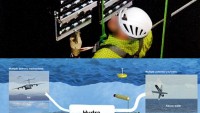DARPA Speeds-up Work on ‘Soft Exosuit’ that will Strengthen US Soldiers
| Arthur Dominic Villasanta | | May 18, 2016 08:41 AM EDT |
(Photo : The Wyss Institute for Biologically Inspired Engineering ) DARPA's soft exosuit prototype for American soldiers. The soft exosuit uses a combination of sensors (shown by the numbers) to increase the wearer's strength and endurance, and to protect him from injury and physical stress.
American soldiers will one day go into battle wearing form-fitting "Soft Exosuits" under their combat uniforms that make them physically stronger and better able to endure fatigue.
Remarkable progress is being made in developing these modern day exoskeletons that look a lot like the sleek swimsuits worn by Olympic swimmers instead of the clunky first generation exoskeletons made of metal that encased a wearer's arms and legs.
Like Us on Facebook
The clothing-like Soft Exosuit has been described as a "Wearable Robot" by the U.S. Defense Advanced Projects Research Agency (DARPA) that's commissioning universities and research institutions to advance this military technology. The DARPA Soft Exosuit is part of the agency's Warrior Web program.
A prototype Soft Exosuit had a series of webbing straps around the lower half of the body with a low-power microprocessor and a network of flexible strain sensors. These electronics act as the "brain" and "nervous system" of the Soft Exosuit. They continuously monitor data signals, including suit tension, wearer position (walking, running, crouched) and more.
In 2014, DARPA awarded $2.9 million to The Wyss Institute for Biologically Inspired Engineering at Harvard University to further develop its Soft Exosuit, other versions of which might eventually help persons (military and civilian) with limited mobility.
The Wyss Institute said its exosuits are a new class of applications for "soft robotics," an emerging field that combines classical robotic design and control principles with active soft materials.
Its lightweight Soft Exosuit doesn't contain any rigid elements. This means the wearer's bone structure must sustain all the compressive forces normally encountered by the body
Its exosuit consists mostly of specially designed fabrics that can be significantly lighter than a metal exoskeleton since it has no rigid structure. It also provides minimal restrictions on a wearer's motions.
Soft Exosuit technology has also led to the development of entirely new forms of functional textiles, flexible power systems, soft sensors and control strategies that enable intuitive and seamless human-machine interaction.
The Soft Exosuit overcomes the disadvantages of traditional, heavier exoskeleton systems such as power-hungry battery packs and rigid components that can interfere with natural joint movement.
"While the idea of a wearable robot is not new, our design approach certainly is," said Conor Walsh, an assistant professor of mechanical and biomedical engineering at Harvard's School of Engineering and Applied Sciences and founder of the Harvard Biodesign Lab.
In addition to its military application, the team will collaborate with clinical partners to develop a medical version of the suit that could greatly benefit stroke victims, for example, whose gait often becomes slow and inefficient.
Recently, The Wyss Institute began collaborating with ReWalk Robotics Ltd. to accelerate the development of Soft Exosuit technologies for assisting people with lower limb disabilities. The agreement with ReWalk will help speed the design of assistive exosuits that could help patients suffering from stroke and multiple sclerosis to regain mobility.
TagsSoft Exosuit, Defense Advanced Projects Research Agency, DARPA, The Wyss Institute for Biologically Inspired Engineering, Harvard University, Conor Walsh
©2015 Chinatopix All rights reserved. Do not reproduce without permission
EDITOR'S PICKS
-

Did the Trump administration just announce plans for a trade war with ‘hostile’ China and Russia?
-

US Senate passes Taiwan travel bill slammed by China
-

As Yan Sihong’s family grieves, here are other Chinese students who went missing abroad. Some have never been found
-

Beijing blasts Western critics who ‘smear China’ with the term sharp power
-

China Envoy Seeks to Defuse Tensions With U.S. as a Trade War Brews
-

Singapore's Deputy PM Provides Bitcoin Vote of Confidence Amid China's Blanket Bans
-

China warns investors over risks in overseas virtual currency trading
-

Chinese government most trustworthy: survey
-

Kashima Antlers On Course For Back-To-Back Titles
MOST POPULAR
LATEST NEWS
Zhou Yongkang: China's Former Security Chief Sentenced to Life in Prison

China's former Chief of the Ministry of Public Security, Zhou Yongkang, has been given a life sentence after he was found guilty of abusing his office, bribery and deliberately ... Full Article
TRENDING STORY

China Pork Prices Expected to Stabilize As The Supplies Recover

Elephone P9000 Smartphone is now on Sale on Amazon India

There's a Big Chance Cliffhangers Won't Still Be Resolved When Grey's Anatomy Season 13 Returns

Supreme Court Ruled on Samsung vs Apple Dispute for Patent Infringement

Microsoft Surface Pro 5 Rumors and Release Date: What is the Latest?














